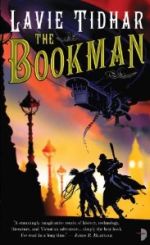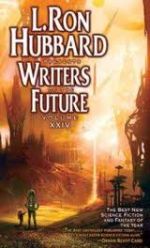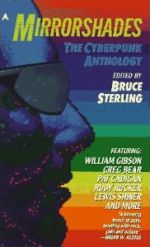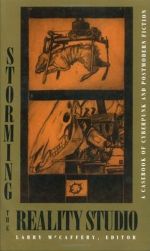Things That Go Bump in the “Might”: SciFi’s Scary Stories
The Invisible Man: A Grotesque Romance (1897)
H.G. Wells’ The Invisible Man’s premise, like Frankenstein’s, is not new. The main idea goes back over two-thousand years, to a story recounted in Plato’s Republic, in which Gyges, a shepherd, finds a ring capable of making one invisible, and uses it to sneak into the palace, sleep with the king’s wife, kill the king, and become king himself. This tale is used to argue that even the seemingly best person would be shown to be in truth corrupt: “Suppose now that there were two such magic rings, and the just put on one of them and the unjust the other; no man can be imagined to be of such an iron nature that he would stand fast in justice. No man would keep his hands off what was not his own when he could safely take what he liked out of the market, or go into houses and lie with any one at his pleasure, or kill or release from prison whom he would, and in all respects be like a God among men.” (Republic, Book II)
This sounds extraordinarily like Griffin, the title figure from H.G. Wells’ story. Rather than find a magic ring, Griffin, a scientist, develops “a method by which it would be possible, without changing any other property of matter–except, in some instances colours–to lower the refractive index of a substance, solid or liquid, to that of air”, thus making it – or him – invisible. One can easily trace Griffin’s rapid corruption after he bestows this power upon himself. “Whatever I did, whatever the consequences might be, was nothing to me. I had merely to fling aside my garments and vanish. No person could hold me. I could take my money where I found it.” He progresses from simple thieving, to arson, assault and battery, murder, and finally plans for world domination. Speaking of himself in third person, Griffin boasts, “And that Invisible Man … must now establish a Reign of Terror. Yes; no doubt it’s startling. But I mean it. A Reign of Terror. He must take some town like your Burdock and terrify and dominate it. He must issue his orders. He can do that in a thousand ways–scraps of paper thrust under doors would suffice. And all who disobey his orders he must kill, and kill all who would defend them.”
Like Shelley’s story also, The Invisible Man spawned various retellings, including the black-and-white film version of the same title with Claude Rains (1933) and the Kevin Bacon modernization Hollow Man (2000). However, these film versions blame the corruption and violence of the invisible man on certain adverse reactions to the chemicals used in the transformation. Even Tolkien’s Lord of the Rings (clearly influenced by the tale of Gyges) blames the corruption of the Ring’s wearers on the evil supernatural influence of Sauron who created It, rather than on the true evil which lies deep within one’s own self. H.G. Wells’ story is much more true to Plato’s parable, and thus is much more frightening, for it shows us the selfishness and wickedness which lurks in everyone, waiting only the right circumstance to emerge.
At the Mountains of Madness (1936)
H.P. Lovecraft’s novella At the Mountains of Madness is a landmark in its author’s career. It marks the point at which Lovecraft’s earlier weird tales suddenly are ‘retconned’ into science fiction. Lovecraft scholar S.T. Joshi calls this science-fictionization of the formerly supernatural elements of Lovecraft’s fiction ‘demythology.’
In At the Mountains of Madness, all of the supernatural creatures of his previous works which have become collectively called the ‘Cthulhu Mythos’ are revealed to be either aliens or the constructs of aliens, and even the Necronomicon, that famed and frightful fictional text referred to in earlier stories, turns out to derive from fragmented prehistoric racial memories of primal humans uplifted by the ancient alien civilization known as the Old Ones.
The story is set in Antarctica, which even today is largely unexplored, providing a ‘final frontier’ for scientific exploration – and for science fiction. The southernmost continent has been used as a setting for a number of scifi films for precisely that reason. The X-Files movie and Alien vs Predator are just two recent examples in Lovecraft’s tradition of finding traces of ancient alien civilizations there. (FYI: Director Guillermo del Toro has long been planning a film version of At the Mountains of Madness, and though Redstone’s devoted readers will know of my mixed feelings regarding film adaptations of classic scifi, I have to say I’m looking forward to it.) The narrator Dyer, a geologist, has returned from a scientific expedition (sponsored by Miskatonic University, of course) which set out with high tech drilling equipment to procure rock and soil specimens from deep beneath the Antarctic ice. But now that a new expedition has been planned for the same region, Dyer is forced to reveal what they really found in order to warn away would-be explorers, to prevent dire consequences for the entire human race should the area beyond the polar mountains be further disturbed.
Lovecraft shares the epistolary tradition of Shelley, but provides a contemporary updating of it. Instead of the story being told through letters and journals, Dyer includes quotes from radio broadcasts which were relayed back to New England by his expedition. Dyer is hesitant to speak too plainly, hinting at more than he reveals, and suggesting the ultimate ineffability of what he wishes to explain. Lovecraft’s cryptic style thus creates a subtle Hitchockian-type suspense of mood and imagery, as the following excerpt illustrates: “The touch of evil mystery in these barrier mountains, and in the beckoning sea of opalescent sky glimpsed betwixt their summits, was a highly subtle and attenuated matter not to be explained in literal words. Rather was it an affair of vague psychological symbolism and aesthetic association—a thing mixed up with exotic poetry and paintings, and with archaic myths lurking in shunned and forbidden volumes. Even the wind’s burden held a peculiar strain of conscious malignity; and for a second it seemed that the composite sound included a bizarre musical whistling or piping over a wide range as the blast swept in and out of the omnipresent and resonant cave mouths.”
























3 comments
I found that the short story ‘The Dreams in the Witch House’ was a bridge between horror and science in Lovecraft’s writing. The formulae used by Keziah Mason were magic as the Puritans understood them, but it can be argued that they were math equations that opened a fourth dimension.
The scariest SF I ever read was Ellison’s “I Have No Mouth, But I Must Scream”. Yikes! That kept me up at night. Check it out, if you dare.
[…] Things That Go Bump in the “Might”: SciFi’s Scary Stories by Henry CribbsInterviews An Interview with editor John Joseph Adams by Michael […]